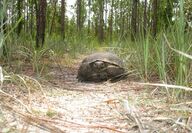Sorted by date Results 1 - 4 of 4

The Florida Fish and Wildlife Conservation Commission (FWC) is seeking public input on draft revisions to the Gopher Tortoise Management Plan. The Management Plan outlines the necessary objectives and conservation actions needed to lower the rate of gopher tortoise population declines and ultimately remove the species from the Florida Endangered and Threatened Species List. Themes of the proposed revisions include 1) streamlining and aligning with other FWC management plans,...

The Florida Fish and Wildlife Conservation Commission's (FWC) volunteer program helps Floridians get directly involved with conservation and restoration projects across the state. Last year, over 1,000 volunteers put in over 60,000 hours to advance FWC's mission. One important project that could not have gotten off the ground without the help of dedicated volunteers is the Kestrel Nest Box Monitoring Program, which has collected data essential to efforts to protect these...

The Florida Fish and Wildlife Conservation Commission (FWC) has been notified by the National Veterinary Services Laboratory of confirmed cases of Highly Pathogenic Avian Influenza (HPAI) strain: H5 2.3.4.4 in a lesser scaup, black vultures and other avian species. There is a low risk of HPAI transmission to humans and, to date, there have been no known human infections in North America. The FWC is currently investigating bird mortalities in Brevard, Indian River and Volusia...

Different species of birds build their nests in all sorts of different places – high in the treetops, deep in thick shrubs, even hiding in plain sight on the ground. Some birds will only build their nests within the protection of a hole. These cavity nesting species fall into two categories. Primary cavity nesters, such as woodpeckers, can excavate their own holes. Other species including bluebirds, tree swallows, screech owls and kestrels are secondary cavity nesters; they a...